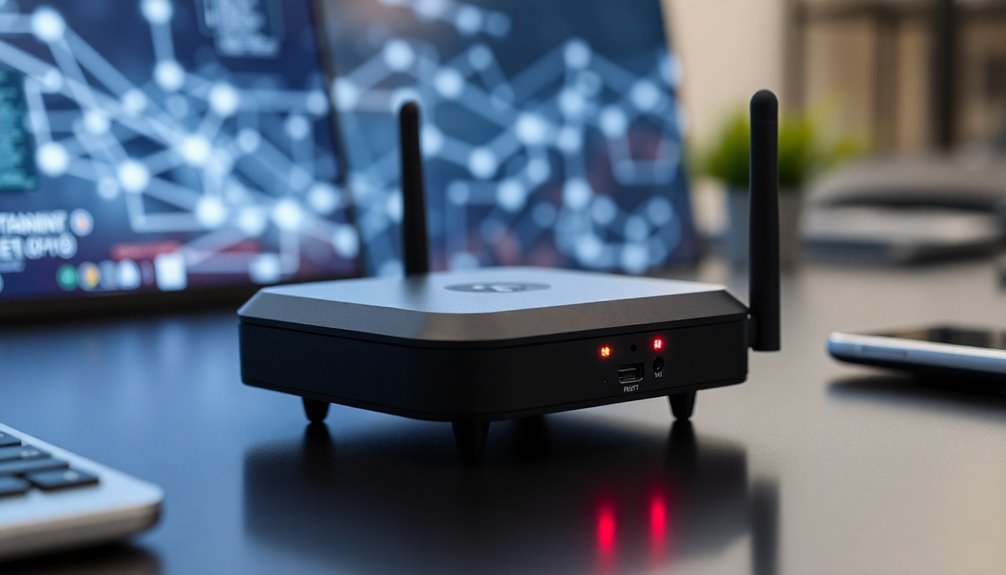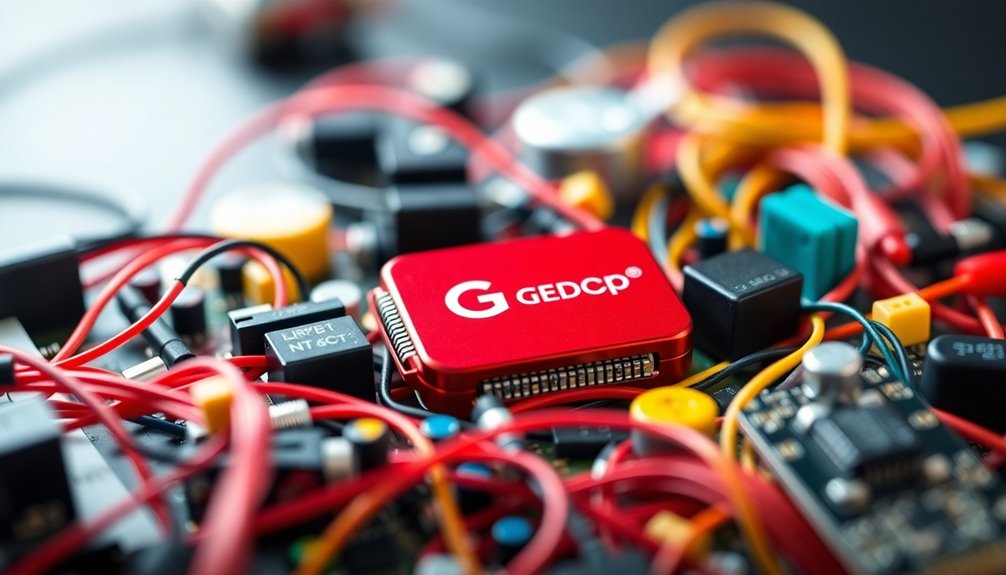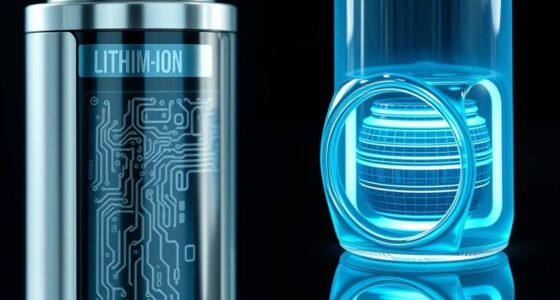5G RedCap is shaping the future of IoT by offering a lightweight, cost-effective connectivity solution designed for low-power devices like wearables, sensors, and cameras. It simplifies network architecture, reduces costs, and enhances energy efficiency with features like power-saving modes and adaptive algorithms. By bridging technologies like NB-IoT and LTE, RedCap supports wide-ranging applications in smart cities, healthcare, and industry. To discover how this innovative technology can transform your projects, explore further details below.
Key Takeaways
- 5G RedCap provides low-cost, energy-efficient connectivity for lightweight IoT devices like wearables and sensors.
- It simplifies device architecture by scaling back advanced 5G features, reducing costs and power consumption.
- RedCap enhances interoperability across LTE, NB-IoT, and 5G, supporting diverse industries like smart cities and healthcare.
- Its technical design includes reduced bandwidth, simplified MIMO, and power-saving features like DRX and PSM.
- Adaptive algorithms and intelligent network management extend device lifespan and optimize energy use in various environments.
Understanding 5G RedCap and Its Role in IoT

Have you ever wondered how 5G can support low-cost, low-power IoT devices? 5G RedCap, or Reduced Capability, is a feature from 3GPP Release 17 that makes this possible. It’s designed for devices like wearables, sensors, and cameras that don’t need full 5G functionalities. RedCap simplifies device design by scaling back advanced features, reducing costs, and improving power efficiency. It bridges the gap between low-data-rate technologies like NB-IoT and LTE Cat-M and high-speed 5G broadband. This allows hardware makers to migrate from LTE to 5G without the complexity of full capabilities. standardized security protocols that help protect data transmitted over these networks. Additionally, RedCap supports interoperability with existing LTE networks, easing the transition for network operators and device manufacturers. It also enhances the visual quality of images and videos transmitted over 5G networks. Moreover, incorporating power management strategies is crucial for the widespread adoption of these devices. Furthermore, understanding how to manage battery life is crucial for the widespread adoption of these devices. Overall, RedCap expands the 5G ecosystem, supporting a broader range of IoT applications while ensuring devices remain affordable and energy-efficient.
Key Technical Features and Performance Benefits

5G RedCap’s key technical features are designed to optimize performance for low-cost, low-power IoT devices. It operates with reduced bandwidth—typically 20 MHz in sub-7 GHz bands and up to 100 MHz in mmWave—making spectrum use more efficient. Its simplified device architecture reduces complexity and costs, employing single antennas and fewer radio features, which shrinks device size and BOM expenses. Support for reduced MIMO layers and half-duplex FDD operation cuts power consumption and extends battery life. It delivers peak data rates comparable to LTE Cat-4 and Cat-6, with latency similar to 4G LTE, suitable for real-time applications. Power-saving techniques like DRX and PSM further enhance efficiency. Additionally, the spectrum allocation for RedCap is optimized to support widespread IoT deployments without interference. This careful design also considers the regulatory environment, ensuring compliance across different regions and facilitating global adoption. Moreover, attention to noise levels ensures that devices can operate reliably in various environments. Implementing comprehensive security features is vital to protect IoT data and maintain trust in connected systems. Overall, these features enable scalable, cost-effective, and energy-efficient IoT deployments without compromising essential performance.
Cost-Effective Solutions for a Diverse IoT Ecosystem

To build a cost-effective IoT ecosystem, leveraging flexible data plans and enabling technologies is essential. Pay-As-You-Go (PAYG) plans offer flexibility by charging only for actual data use, preventing overspending. Combining PAYG with smart optimization tools lets you dynamically adjust data consumption based on real-time needs, maximizing efficiency. Scalable plans help accommodate fluctuating device activity without costly upgrades or wasted bandwidth. Regional coverage and pricing differences among network providers influence overall costs, so choosing wisely is vital. Enabling technologies like cloud computing reduce infrastructure expenses with on-demand resources, while edge computing cuts bandwidth and latency costs by processing data near devices. Using low-power wireless protocols such as LoRaWAN or NB-IoT further lowers operational expenses, creating an affordable, adaptable IoT ecosystem. Additionally, understanding Nutritional Advantages of Green Juice can inform the development of health-focused IoT applications for wellness monitoring. Incorporating low-power protocols and optimizing data usage are crucial strategies to minimize energy consumption and extend device lifespan in a diverse IoT landscape. Employing energy-efficient hardware can significantly reduce long-term operational costs. Implementing best practices for device maintenance ensures longevity and consistent performance of IoT devices, further reducing costs. Exploring beach destinations can also inspire innovative outdoor and wellness-related IoT solutions tailored for leisure and health activities.
Ideal Applications Transforming Industries

Across various industries, the adoption of specialized 5G RedCap applications is revolutionizing how businesses operate and serve their communities. In smart cities, you can implement efficient street lighting, reduce energy costs, and monitor air quality with real-time sensors. Smart parking systems become more effective by connecting sensors that track space occupancy, easing traffic congestion. Public safety improves through connected cameras and emergency alerts, while infrastructure monitoring links structural sensors on bridges and tunnels to minimize downtime. In industrial settings, reliable, low-latency connectivity supports equipment monitoring, robotics, and asset tracking, enabling predictive maintenance and seamless upgrades. Healthcare benefits from continuous remote monitoring and secure medical device communication. Agriculture advances with soil sensors, autonomous equipment, and environmental sensors, optimizing yields and conserving resources. Additionally, AI-powered security solutions can enhance the protection of these connected systems against cyber threats, ensuring data integrity and operational resilience. The integration of specialized IoT applications further streamlines industry workflows and enhances overall efficiency. By leveraging reliable connectivity, industries can ensure consistent data flow and real-time decision-making capabilities across all applications.
Enhancing Device Longevity With Energy-Efficient Connectivity

Implementing energy-efficient connectivity features in RedCap devices substantially boosts their operational lifespan. Features like extended Discontinuous Reception (eDRX) allow your devices to sleep longer, conserving power during idle periods. Upcoming functionalities like Wake Up Signal (WUS) and early paging indication (PEI) will further reduce unnecessary wake-ups, saving battery life. Simplified protocol stacks and fewer antennas lower energy consumption by decreasing transmission and processing demands. Smaller chipsets and integrated modules lessen the load on power-hungry components, extending device longevity. Network features such as network slicing, reduced signaling, and adaptive power control optimize energy use during data transfer. Additionally, tuning options inspired by Honda Tuning — such as ECU optimization and component upgrades — can be adapted to IoT device firmware to further enhance energy efficiency. Understanding battery management principles is crucial for maximizing device performance over time. Incorporating automated network management can further streamline power optimization processes, ensuring devices adapt dynamically to network conditions for maximum efficiency. Leveraging power management techniques rooted in somatic awareness principles can help optimize the device’s energy consumption by aligning operational demands with environmental cues and user activity. Moreover, integrating adaptive algorithms that respond to changing usage patterns can further prolong battery life and improve overall device reliability.
Frequently Asked Questions
How Does 5G Redcap Compare to LTE-M and Nb-Iot?
You’re wondering how 5G RedCap compares to LTE-M and NB-IoT. RedCap offers higher data rates and lower latency, making it suitable for more demanding IoT applications. It seamlessly integrates with existing 5G networks and operates across all spectrum bands. While RedCap is more expensive than LTE-M and NB-IoT, it provides better performance and scalability, ideal for applications needing faster, real-time data processing.
What Are the Main Limitations of 5G Redcap Devices?
Imagine deploying RedCap devices in a smart city project. The main limitations you face include restricted bandwidth—up to 20 MHz or 100 MHz depending on the frequency—and support for only two antennas, limiting MIMO capabilities. You also can’t use carrier aggregation or support dual connectivity, which reduces throughput. These hardware and network constraints can affect performance, especially in remote areas or high-demand scenarios, making it essential to consider these factors during planning.
Is 5G Redcap Suitable for Real-Time Industrial Automation?
You’re asking if 5G RedCap suits real-time industrial automation. Yes, it does. Its low latency and reliable communication support rapid responses, essential for factory automation and remote control. You’ll benefit from near real-time data transmission, reducing downtime and increasing efficiency. Plus, it connects a broad range of IoT devices, helping you implement smart manufacturing. However, consider bandwidth limits and integration challenges to guarantee ideal performance in your specific industrial environment.
Can Existing 4g/5g Networks Support Redcap Without Upgrades?
Think of your network like a well-stocked toolbox. You can support RedCap devices with your existing 4G and 5G networks, much like using familiar tools for new projects. Most core network elements only need software updates, not hardware replacements. RedCap’s design aligns with current spectrum allocations and infrastructure, so your network can handle these IoT devices without major upgrades, enabling a seamless progression to more efficient, mid-tier connectivity.
What Security Features Are Integrated Into 5G Redcap Devices?
You might wonder what security features 5G RedCap devices include. These devices incorporate advanced encryption protocols, ensuring data remains confidential during transmission. They also use strong authentication and secure boot processes to verify device and user identities, preventing unauthorized access. Additionally, they support encrypted over-the-air updates, protect against hardware and firmware attacks, and implement layered security measures, all designed to safeguard your IoT ecosystem efficiently and cost-effectively.
Conclusion
5G RedCap is like a breath of fresh air for IoT, offering a lightweight, efficient connectivity solution that fits seamlessly into your device ecosystem. It boosts performance, cuts costs, and extends device life—making your IoT deployments smarter and more sustainable. As reliable as your favorite shortcut, RedCap simplifies your connectivity needs while opening doors to innovative applications across industries. Embrace this future and watch your IoT landscape flourish with agility and efficiency.









